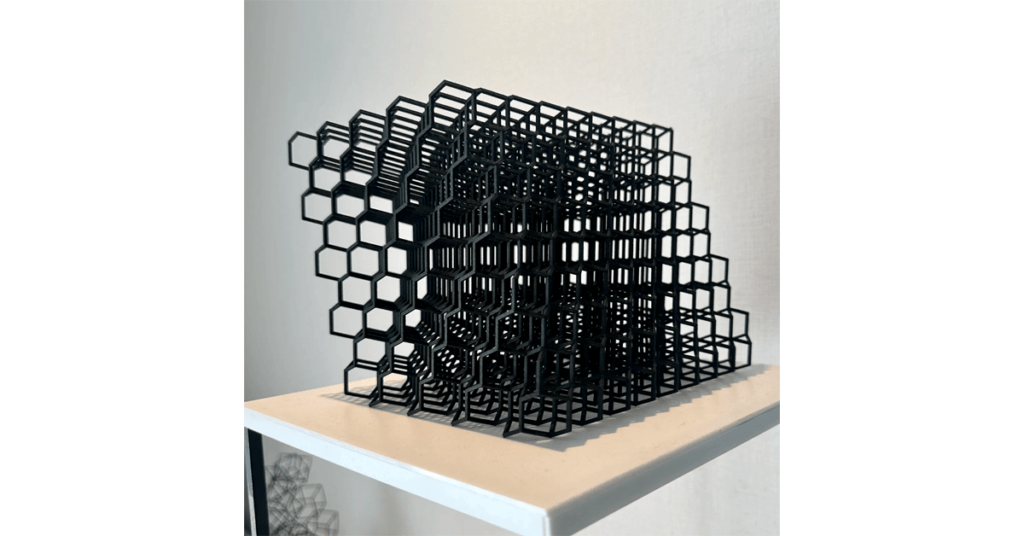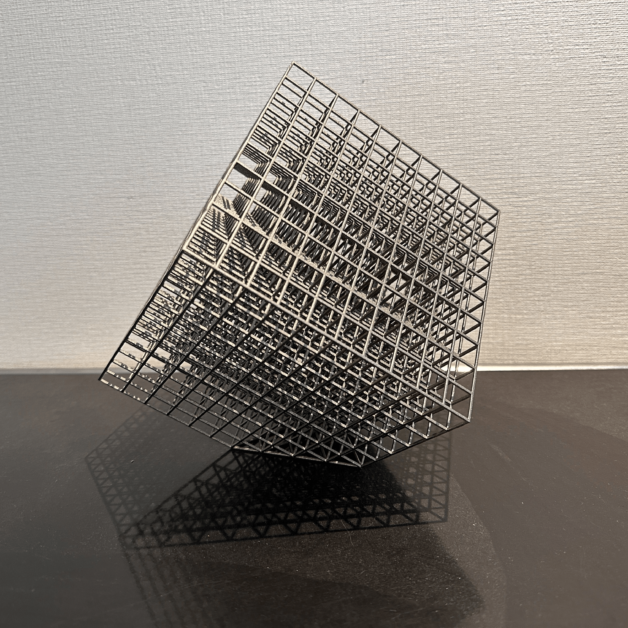[Art Gallery Project] Kiyoo Ota Solo Exhibition “Grid”: A Visual Labyrinth Woven with Order and Illusion
The solo exhibition “Grid” by artist Kiyoo Ota, who elevates architectural perspectives into art, is currently being held at GARDE Gallery in Aoyama, Tokyo.
(Exhibition Period: Friday, February 21 – Saturday, March 8, 2025)
We spoke with Ota about the appeal of this exhibition and his future artistic direction.
In “Grid”, Ota explores the concept of grids—an idea he has long pursued—through a variety of artistic expressions, including paintings, sculptures, and installations. Grids, commonly used in fields such as architecture, design, mathematics, and urban planning, are composed of structured lines and points, serving as a fundamental framework that visually and physically conveys order and structure. However, Ota does not merely treat grid structures as rigid frameworks; instead, he constantly seeks new artistic possibilities by incorporating visual effects that challenge and expand conventional perceptions.

One of the most striking aspects of the exhibition is the collection of works utilizing moiré patterns. When meticulously drawn grid patterns overlap, they create a moiré effect that, depending on the viewer’s angle and distance, produces wave-like movements and vibrations. This dynamic illusion brings an unexpected sense of motion to what would otherwise be a static composition.
(Moiré: A visual phenomenon where overlapping layers of regularly arranged dots or lines create an interference pattern of wavy or rippling stripes.)
Additionally, the exhibition features works that deconstruct and reconstruct the cube, a fundamental shape in architecture. By intricately intersecting the cube’s surfaces and lines, these pieces challenge the illusions created by perspective and push its limits, blurring the boundaries between two-dimensional and three-dimensional space to create a unique visual experience.
Regarding this exhibition, Ota shared the following comment:
“The essence of my work is difficult to fully convey through photos or videos. In particular, the pieces utilizing moiré patterns must be seen, felt, and experienced firsthand to truly appreciate their intrigue and uniqueness. I encourage visitors to immerse themselves in the artwork, sense the shifting space and illusions with their own bodies, and freely explore the spatial transformations.”
Future Outlook: Expanding into Public Art
With a background in architecture, Ota is exploring new possibilities in the field of public art. He envisions integrating his works into everyday spaces such as parks and office entrances, making art a more accessible and immersive part of daily life.
Building on his past exhibitions in China and Taiwan, Ota aims to further deepen the connection between architecture and art through his work. His future plans include expanding his exhibitions beyond Japan, actively showcasing his art in major cities worldwide, including New York, Milan, and Paris.
Kiyoo Ota
Born: 1981, Aomori Prefecture (raised in Akita Prefecture)
Education
2007: Completed Master’s Program, School of Engineering, The University of Tokyo
2005: Graduated from the Department of Architecture, Kyoto University
Selected Solo Exhibitions
2024: Order, Gallery TK2
2023: Geometry, Daimaru Umeda Store
2023: Cosmos, Miaki Gallery
2023: Reality, Tagboat Gallery at Hankyu Men’s Tokyo
Selected Group Exhibitions / Art Fairs
2024: Art Central, Hong Kong
2024: ART ART TOKYO, Daimaru Tokyo Store
2024: ART SHINSAIBASHI, Shinsaibashi PARCO
2023: West Bund Art & Design, Shanghai
2023: Sarugaku Festival Art Fair, Art Front Gallery
2023: CHAPTER PATINA, Amanyangyun (Amanyang, Shanghai)
2023: Onbeat Art Show, Ginza Mitsukoshi
2023: China-Japan-Korea Sculpture Invitational Exhibition, Ministry of Culture of China, 2023: Qingdao Sculpture Art Museum
2023: Tennoz Canal Fes, WHAT CAFE, Terrada Warehouse
2023: Pre-Breakout Artists Exhibition, Ginza Six
2023: Contemporary Art from Around the World 2023, Daimaru Hakata Tenjin Store
2023: Instagram: https://www.instagram.com/otakiyoo/
Kiyoo Ota Solo Exhibition “Grid”
Dates:February 21 (Fri.) – March 8 (Sat.), 2025 *Closed on Sundays and holidays
Hours:11:00-18:00
Venue:GARDE Gallery (NBF ALLIANCE Bldg. 4F, 5-2-1 Minami Aoyama, Minato-ku, Tokyo)
Admission:free
URL:https://www.art-adf.jp/?sl=en
Kiyoo Ota – Upcoming Exhibition Announcement
“Kokon Tozai” (All times and places)
Set in a Registered Tangible Cultural Property with over a century of history, this exhibition will showcase 14 next-generation artists.
Participating Artists:
Yukino Oishi / Kiyoo Ota / Yoichiro Otani / Chika Kato / Yoshitoshi Kanemaki / Yu Kawashima / Kayoko Kimura / Ryosuke Shiomi / Yosuke Takasaki / Yoshiyasu Tamura / Momoko Nakamura / Yukihiko Haruta / Ryota Nishioka / Jun Matsumura
Exhibition Dates:
April 12 – April 30, 2025 | 13:00 – 20:00
- General Public Access (Free Admission): Fridays, Saturdays, Sundays
- Reservation Required: Mondays to Thursdays (Please contact the exhibition office in advance via email.)
Venue:
Kyo Art
402 Mongaicho, Shimogyo-ku, Kyoto City, Kyoto Prefecture (Shichijo-dori, Horikawa East Entrance, North Side)
Contact Information:
Exhibition Office:kokontozai.art@gmail.com



















